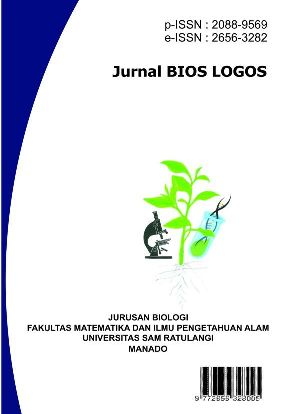Deteksi Unit-unit CRISPR (Clustered Regularly Interspaced Short Palindromic Repeat) pada Genom Beberapa Mikroba yang Berasosiasi dengan Ascidia Laut
DOI:
https://doi.org/10.35799/jbl.v13i2.48847Keywords:
CRISPR, Genom, Mikroba laut, CRISPRCasFinderAbstract
Sekuens CRISPR merupakan suatu rangkaian nukleotida pada genom banyak mikroba yang terdiri dari urutan-urutan nukleotida palindromik berulang yang mengapit sekuens spesifik yang berasal dari asam nukleat asing. Studi ini bertujuan untuk memperoleh data sekuens genom beberapa mikroba dari komunitas mikrobioma ascidia yang tersedia di NCBI GenBank®, serta mendeteksi keberadaan unit-unit CRISPR pada genom mikroba tersebut dengan analisis in silico menggunakan CRISPRCasFinder. Data sekuens genom utuh berhasil diperoleh untuk Synechococcus sp. PCC 7002 (3.008,047 MB), Leptolyngbya sp. PCC 7376 (5.125,950 MB), Candidatus endolissoclinum faulkneri L2 (1.481,191 MB), dan Prochlorococcus marinus (1.751,080 MB), juga urutan genom shotgun untuk ketiga strain Prochloron didemni (P2-Fiji, P3-Solomon dan P4-Papua New Guinea) masing-masing dengan ukuran 84,370; 40,852; dan 64,281 MB. Sekuens CRISPR terdeteksi pada tiga dari tujuh genom mikroba dengan kisaran 2-20 unit CRPSR. Tipe sistem CRISPR-Cas perlu ditelusuri lebih lanjut ke depan.
References
Alkhnbashi, O. S., Mitrofanov, A., Bonidia, R., Raden, M., Tran, V., Eggenhofer, F., Shah, S., Öztürk, E., Padilha, V., Sanches, D., De Carvalho, A., & Backofen, R. (2021). CRISPRloci: comprehensive and accurate annotation of CRISPR–cas systems. Nucleic Acids Research, 49(W1), W125-W130.
Barrangou, R., Marraffini, L. A., & Sontheimer, E. J. (2022). CRISPR‐cas systems: Core features and common mechanisms. Dalam R. Barrangou., E.J. Sontheimer., & L.A. Marraffini. CRISPR Biology and Applications, 1-12. ASM Press.
Chen, L., Hu, J., Xu, J., Shao, C., & Wang, G. (2018). Biological and chemical diversity of ascidian-associated microorganisms. Marine Drugs, 16(10), 362.
Couvin, D., Bernheim, A., Toffano-Nioche, C., Touchon, M., Michalik, J., Néron, B., Rocha, E. P., Vergnaud, G., Gautheret, D., & Pourcel, C. (2018). CRISPRCasFinder, an update of CRISRFinder, includes a portable version, enhanced performance and integrates search for cas proteins. Nucleic Acids Research, 46(W1), W246-W251.
Donia, M. S., Fricke, W. F., Ravel, J., & Schmidt, E. W. (2011). Variation in tropical reef symbiont Metagenomes defined by secondary metabolism. PLoS ONE, 6(3), e17897.
Flombaum, P., Gallegos, J. L., Gordillo, R. A., Rincón, J., Zabala, L. L., Jiao, N., Karl, D. M., Li, W. K., Lomas, M. W., Veneziano, D., Vera, C. S., Vrugt, J. A., & Martiny, A. C. (2013). Present and future global distributions of the marine Cyanobacteria Prochlorococcus and Synechococcus. Proceedings of the National Academy of Sciences, 110(24), 9824-9829.
Knott, G. J., & Doudna, J. A. (2018). CRISPR-Cas guides the future of genetic engineering. Science, 361(6405), 866-869.
Kühl, M., Behrendt, L., Trampe, E., Qvortrup, K., Schreiber, U., Borisov, S. M., Klimant, I., & Larkum, A. W. (2012). Microenvironmental ecology of the chlorophyll B-containing symbiotic Cyanobacterium Prochloron in the Didemnid ascidian Lissoclinum patella. Frontiers in Microbiology, 3.
Kwan, J. C., Donia, M. S., Han, A. W., Hirose, E., Haygood, M. G., & Schmidt, E. W. (2012). Genome streamlining and chemical defense in a coral reef symbiosis. Proceedings of the National Academy of Sciences, 109(50), 20655-20660.
Lindell, D. (2014). The genus Prochlorococcus, phylum Cyanobacteria. The Prokaryotes, 829-845.
Ludwig, M., & Bryant, D. A. (2012). Synechococcus Sp. Strain PCC 7002 Transcriptome: Acclimation to temperature, salinity, oxidative stress, and mixotrophic growth conditions. Frontiers in Microbiology, 3.
Makarova, K. S., & Koonin, E. V. (2015). Annotation and classification of CRISPR-Cas systems. Methods in Molecular Biology, 47-75.
Mojica, F. J., & Garrett, R. A. (2012). Discovery and seminal developments in the CRISPR Field. CRISPR-Cas Systems, 1-31.
Okoli, A. S., Blix, T., Myhr, A. I., Xu, W., & Xu, X. (2021). Sustainable use of CRISPR/Cas in fish aquaculture: The biosafety perspective. Transgenic Research, 31(1), 1-21.
Rumengan IFM. (2021). Mikroba Laut sebagai penyedia perangkat penyuntingan genom. Dalam Pengelolaan Sumberdaya Laut Berkelanjutan. Book Chapter, 1-20. Unsrat Press.
Rumengan, I. F., Roring, V. I., Haedar, J. R., Siby, M. S., Luntungan, A. H., Kolondam, B. J., Uria, A. R., & Wakimoto, T. (2021). Ascidian-associated photosymbionts from Manado, Indonesia: Secondary metabolites, bioactivity simulation, and biosynthetic insight. Symbiosis, 84(1), 71-82.
Schreiber, L., Kjeldsen, K. U., Funch, P., Jensen, J., Obst, M., López-Legentil, S., & Schramm, A (2016). Endozoicomonas are specific, facultative symbionts of sea squirts. Frontiers in Microbiology, 7.
Stal, L.J., & Cretoiu, M.S. (2022). The marine microbiome, Edisi ke-2. The Microbiomes of Humans, Animals, Plants, and the Environment, Springers.
Untu, P., Rumengan, I. F., & Ginting, E. L. (2015). Identifikasi Mikroba Yang Koeksis Dengan ascidia Lissoclinum patella Menggunakan Sekuens Gen 16S rRNA. Jurnal Pesisir dan Laut Tropis, 3(2), 23.
Walter, J. M., Coutinho, F. H., Dutilh, B. E., Swings, J., Thompson, F. L., & Thompson, C. C. (2017). Ecogenomics and taxonomy of Cyanobacteria phylum. Frontiers in Microbiology, 8.
Youssef, D. T., Almagthali, H., Shaala, L. A., & Schmidt, E. W. (2020). Secondary metabolites of the genus Didemnum: A comprehensive review of chemical diversity and pharmacological properties. Marine Drugs, 18(6), 307.
Downloads
Published
How to Cite
Issue
Section
License
Copyright (c) 2023 Trezya Pangemanan, Inneke Rumengan, Kurniati Kemer, Antonius Rumengan, Elvy Ginting, Rosita Lintang, Joudy Sangari

This work is licensed under a Creative Commons Attribution-ShareAlike 4.0 International License.




